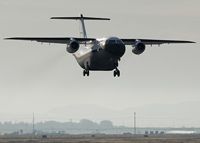 The Air Force Research Laboratory and Lockheed Martin’s Skunk Works have, on June 2, flown their Advanced Composite Cargo Aircraft (ACCA), which they say “has the potential to change aircraft manufacturing as we presently know it, for the better.” ACCA program manager Barth Shenk’s words reinforce that the aircraft itself isn’t designed to be a prototype airframe so much as it is a proof-of-concept technology demonstrator for a composite manufacturing process. The aircraft is basically a modified Dornier 328J in this case built from very large composite sections that are cured and bonded in room-sized ovens. The size of the ovens allows massive parts when compared with what can be produced in more traditional smaller autoclaves, thus minimizing parts counts and complexity during assembly. Compared to the Dornier 328J’s metal aircraft structure, which utilizes roughly 3,000 parts and 30,000 fasteners, the parts count for the ACCA is about 300 parts and 4,000 fasteners. That means significant time and money saved. More important, Shenk believes the benefits are not lost to but may be magnified by scale and further improved by the characteristics of composites themselves.
The Air Force Research Laboratory and Lockheed Martin’s Skunk Works have, on June 2, flown their Advanced Composite Cargo Aircraft (ACCA), which they say “has the potential to change aircraft manufacturing as we presently know it, for the better.” ACCA program manager Barth Shenk’s words reinforce that the aircraft itself isn’t designed to be a prototype airframe so much as it is a proof-of-concept technology demonstrator for a composite manufacturing process. The aircraft is basically a modified Dornier 328J in this case built from very large composite sections that are cured and bonded in room-sized ovens. The size of the ovens allows massive parts when compared with what can be produced in more traditional smaller autoclaves, thus minimizing parts counts and complexity during assembly. Compared to the Dornier 328J’s metal aircraft structure, which utilizes roughly 3,000 parts and 30,000 fasteners, the parts count for the ACCA is about 300 parts and 4,000 fasteners. That means significant time and money saved. More important, Shenk believes the benefits are not lost to but may be magnified by scale and further improved by the characteristics of composites themselves.
Shenk believes that the ACCA manufacturing process can be applied to larger aircraft with the result of significantly lower costs when compared to other manufacturing techniques. In general terms, where traditional aircraft require more parts and more labor as they increase in size, the ACCA’s process does not. Also, the composites are expected to better withstand corrosion than metals and provide greater strength per weight along with more flexibility in design. ACCA’s initial demonstration flight took place June 2 in Palmdale, Calif.


































